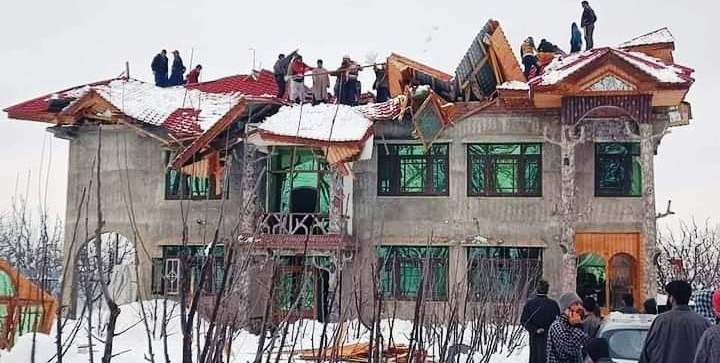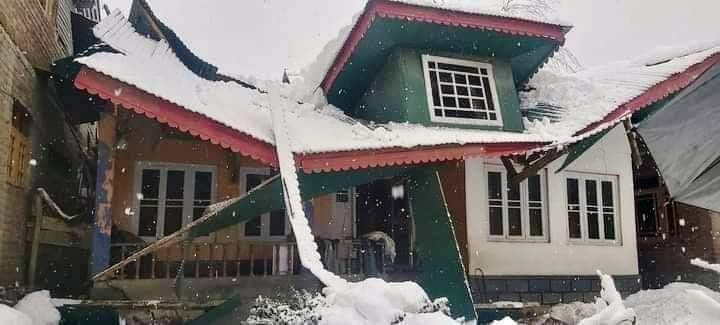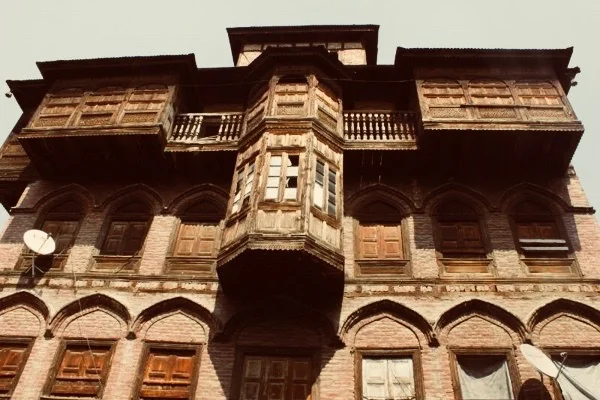
It just took a few days of vintage snowfall to bust the fragile façade of Kashmir’s modern architecture.
By Gowher Hamid
AS ‘blizzard’ thawed and snow-laded rooftops caved in to shock of Kashmir, octogenarian carpenter Abdul Khaliq Zaz stood vindicated.
‘Wousta’ (Master) Khaliq had been predicting this ‘pack of cards’ moment for Kashmir’s new-age architecture for many years now.
“Our idea of living has drastically changed,” said the old-timer sitting in his downtown Srinagar home. “Unlike our forefathers, our idea of construction has now become very cosmetic. But in an unpredictable place like Kashmir, such concept doesn’t work. It just took a few days of snowfall to bust the make-believe façade of our homes.”
On January 6, roofs of many houses caved-in, sending shockwaves across the valley. Viral visuals of snowbound and buried houses panicked many people, who drove out, with spades and shovels, on a desperate snow-clearance drive.

“Last year, the untimely snowfall damaged our trees,” Khaliq continued. “And this year, this heavy snowfall exposed the delicate reality of our houses. These uncertain weather patterns were always there. That’s how winter used to be in Kashmir. But akin to unexpected floods which caught government of the day pants down in 2014, this year’s vintage snowfall exposed our misplaced priorities. It’s clear that Kashmiris are investing more in show than in safety. And in a place like Kashmir, this can prove very dangerous.”
Seconding Khaliq, his 55-year-old apprentice, Rehman Dar, said old houses would withstand heavier snow due to intricate and impeccable carpentry.
“If you see the roof pattern in old houses you will observe many small wooden joints supporting the steep and slippery structure,” Dar said. “Besides the network of those wooden joints, Kashmiri carpenters would nail the roofs extensively. I think this is where the difference lies.”
Set-in-Cement Story
Like these master carpenters of downtown, many see the mindless mushrooming of Kashmir’s new-age architecture as the reason for the caved-in mishaps.
Set in cement, many of these houses greatly altered the architectural landscape of Kashmir from 2000 onwards.
“By then,” said Showkat Khan, an executive engineer from Srinagar, “we were assured about our moderate winters. We would receive very scanty snowfall making many of us believe that Kashmir’s weather patterns have changed for good. As the quest for cemented modern houses increased, mud was snubbed and sand became Kashmir’s ‘only’ construction material.
“But most of us forgot that Kashmir’s winters last for over six months. With the result, we ended up undoing the winter full-proof system in our homes.”
Unlike modern day houses—most of whom fell like a pack of cards during 2005 earthquake—many architectural houses, like a seven-storey house in Anantnag of circa 1930 has survived five earthquakes and two floods, said Saleem Beg.
“That house is still structurally sound,” Beg, convener INTACH, said. “But now, we mostly imitate the warm houses of North India.”
This is where, many believe, Kashmiri architecture—now crumbling under a few days of snowfall—has lost its durable syncretism status and become weak edifices.
“Modernization and technology have been the primary factors for the shift in taste among the natives,” argued scholar Salika Rashid from Srinagar. “Even insulation and comfort were trampled for the ‘cold modernity’.”
But the transition from a mud-wood house to cement-brick structure, the scholar said, has consumed the valley in its grip. “Even though,” she added, “this step was in direction for structural stability only.”
Apart from being a carpentry marvel, Kashmir’s old houses were testifying the traditions of time, she said.

Every house had a wooden balcony attached with a room called Dub. Taq, Dhajji Dewari, wood, mud and bricks were prominently representing the magnificence of architecture. These old structures were warmer, she said, despite lacking the modern-day hamams.
But the construction of modern structures totally dismissed this rich culture and made life numb with cold inside these structures, besides prone to accidents.
“And therefore,” Salika said, “it’s imperative for the people to re-analyze what they are trading for their syncretic beauty and durability because Kashmir is a place which teaches the world about the balance of life with nature.”
Architectural historian, Randolph Langenbach, seconds the scholar’s claims.
In his 1992 paper on Kashmir’s architecture, Langenbach writes that Kashmir could have a lot to teach the world about life in balance with nature, but first it must rediscover the value of its own traditions.
“The place to begin is to rediscover the advantages of the timber and mud houses – not in order to return to the past but to bring this technology into the future as an essential step in the effort to return intrinsic wealth to the people in the form of affordability, comfort, family closeness, and social compatibility.”
A Matter of Safety
As many concrete structures either developed cracks or their roofs caved in due to heavy snowfall lately, many netizens wondered about the safety of their ‘modern’ structures.
Amid debate, many pointed about the practical flaws.
“Almost all houses now have the snow-breakers used atop roofs,” Mir Faheem, a former scribe, said. “May be these are contributors to roof collapses in the wake of heavy snowfall, apart from structural designing or quality of material flaws.”
Is it time to conduct structural audit of houses through professional structural engineers? Faheem asked.
“Because things can’t be left to any chance. Because winters will continue to come, and snow will continue to fall. And because it is a matter of safety of lives, after all!”
Follow this link to join our WhatsApp group: Join Now
Be Part of Quality Journalism |
Quality journalism takes a lot of time, money and hard work to produce and despite all the hardships we still do it. Our reporters and editors are working overtime in Kashmir and beyond to cover what you care about, break big stories, and expose injustices that can change lives. Today more people are reading Kashmir Observer than ever, but only a handful are paying while advertising revenues are falling fast. |
| ACT NOW |
| MONTHLY | Rs 100 | |
| YEARLY | Rs 1000 | |
| LIFETIME | Rs 10000 | |











